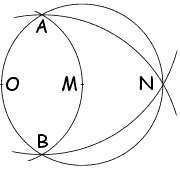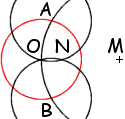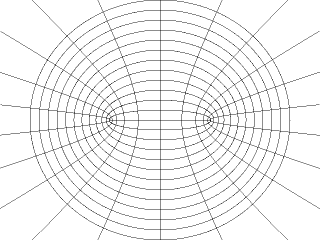
(2004-06-23)
Confocal Conics
Ellipses and hyperbolae sharing the same foci.
In a curvilinear quadrangle formed by two pairs of confocal conics,
the diagonals are equal.

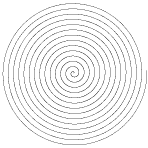 Jerry Southerland
(2005-02-02; e-mail)
Jerry Southerland
(2005-02-02; e-mail)
Spiral of Archimedes
What's the length of the spiral from a vinyl record (or a paper towel roll)
as a function of the distance to the center?
A spiral of Archimedes may be described as the trajectory of a point
which moves at constant speed along a spoke of a wheel rotating at a constant rate.
The distance (r) from the center to a point on the spiral is proportional to the angle
(q) between the spoke and some fixed line.
The polar equation is thus:
r = a q
The angle q (expressed in radians) increases by
2p with each turn.
Therefore, the quantity 2pa is
the thickness of the paper on a roll, or
the distance between adjacent grooves
[parts of the groove, rather] on a vinyl record.
When the polar coordinates (r,q) of a point
change minutely by (dr,dq),
that point travels a minute distance ds, given by the following
relation (obtained from the Pythagorean theorem,
since a curve looks straight at small enough scales):
(ds)2 =
(dr)2 + (r dq)2
In the case of Archimedes' spiral, this means:
ds = a (1 + q 2 )½
dq.
The length (s) of the spiral is obtained by
integrating this:
|
 |
|
 |
|
| s | = |
½ aq |
Ö |
1 + q2 |
+ ½ a ln ( |
Ö |
1 + q2 |
+ q ) |
 |
|
 |
|
 |
|
| = |
½ r |
Ö |
1 + (r/a)2 |
+ ½ a ln ( |
Ö |
1 + (r/a)2 |
+ r/a ) |
For a roll of paper of diameter 2r1 with a core of diameter 2r0
the total length is simply
s(r1)-s(r0).
[Recal that 2pa is the thickness of the paper.]
A Simple Approximation:
The exact formula above is clearly an overkill when it comes to estimating
the length of paper on a roll.
Instead, you may consider that, if the paper is very thin compared to the
diameter of the core, the surface area of the roll's cross section divided
by the thickness (e = 2pa)
of the paper gives you its length, namely:
s »
(r12 - r02 ) / 2a
= p
(r12 - r02 ) / e
This approximation corresponds to the leading term of the above exact formula.
On 2005-02-11, Jerry Southerland
wrote: [edited summary]
For a 65 ft roll of paper towels, 2r1 = 5" and
2r0 = 1.75".
The thickness of the paper, measured with a caliper, is about 0.01".
Plugging this into the formula yields a length of about 144 ft,
which is more than twice the actual value. What's wrong?
|
A paper towel normally has features (fluffiness, waviness, embossment)
which make the caliper measurement of a single sheet greatly underestimate the effective
thickness of the material in a stack or a roll.
By working the formula backwards, the above numbers would indicate that the paper
material has an effective thickness of about 0.022".
This could be obtained directly by counting the number N of turns it takes for the diameter
of the roll to decrease by x inches (the effective thickness of the stuff
would then be x / 2N).
If you insist on using a caliper,
you may reduce by a factor of N the large error obtained for a single
sheet, simply by using the caliper (without squeezing) on a stack of N sheets...
If a roll of paper towels of the type quoted above has a diameter D (in inches)
then its footage is approximately:
( D 2 - 3.06 ) 2.96 ft
(2003-05-25)
Why is it called a "witch" ?

The witch of Agnesi.
Agnesi's cubic (versiera).
[French: agnésienne]
[Spanish: bruja de Agnesi]
The curve's cartesian equation is:
y = a3 / (x2+a2 ).
It's associated with a circle of diameter a
tangent to the x-axis at the origin O.
A point M on this curve may be obtained via a line OPQ where P is on the circle
and Q is at height a; M has the x-coordinate of Q and the y-coordinate of P.
This curve was first considered by:

- Pierre de Fermat (1601-1665) in 1630,
- Luigi Guido Grandi (1671-1742) in 1703,
- Maria Gaëtana Agnesi (1718-1799) in 1748.
It seems you've got to be about 30 years of age to be interested in this...

The Italian name versiera (used by Agnesi) was actually given to the curve by
Grandi in 1718, because of the "inverted sine" (sinus versus)
which is used in its construction.
In spite of what is often stated, there may not be any direct relation
with the Latin word versoria which denotes the rope used
on a sailboat to transfer edge (the verb vertere means "to turn").
The weird name of "witch" comes from a famous mistranslation
by the Lucasian professor of mathematics at Cambridge, John Colson (1680-1760).
When he translated Maria Agnesi's Istituzioni Analitiche
[written in 1748, this was the first calculus book ever authored by a woman]
Colson apparently mistook "la versiera" for "l'avversaria"...
Since l'avversario (the adversary) is the Devil,
an avversaria would be a she-devil, or a witch!
Colson's work seems also responsible for the attribution of the curve to Agnesi
(she made no such claim herself).
The area between the versiera and its asymptote [the x-axis]
is pa2,
which happens to be exactly 4 times the area of the associated circle.
The function
a / p(x2+a2 )
thus corresponds to the density of a continuous probability distribution.
The standard deviation of this distribution is infinite...
(2004-06-23)
Folium of Descartes
Its cartesian equation is:
x 3 + y 3 = 3axy
The asymptote is of equation:
x + y + a = 0

(2004-06-21)
Lemniscate of Bernoulli
The Latin word "lemniscus" means pendant ribbon.
This name was first used in 1694 by Jacob Bernoulli (1654-1705)
to describe the above planar curve, which is now named after him.
A lemniscate of Bernoulli may be defined as the particular
Cassinian oval which goes through the
midpoint between its foci.
If 2a is the distance between the foci,
the lemniscate's cartesian equation in the proper coordinate system is:
( x 2 + y 2 ) 2 =
2 a 2 ( x 2 - y 2 )
The horizontal width of the curve is 2Ö2 a,
while its height (or vertical width) is simply a.
The surface area of each lobe happens to be simply a2.
(2004-06-21)
Ovals of Cassini
/ Cassinian Ovals
/ Cassini Ovals
The Cassini ovals are those curves along which the product of the
distances to two given points, called foci, is a constant
[ foci, plural of focus, is pronounced "foe-sigh"].
By contrast, the sum
of these two distances is a constant along an ellipse...
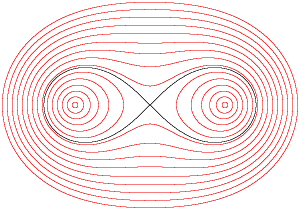
(2004-06-22)
Cardioid & Limaçons of Pascal
These curves are named after
Etienne
Pascal (1588-1651), the father of the French scientist and
philosopher Blaise Pascal (1623-1662).
Etienne Pascal was part of a circle of mathematicians who held weekly meeting in Paris,
around Marin Mersenne (1588-1648).
 This famous mathematical group included
the likes of
Pierre Hérigone (1580-1643),
Claude Mydorge (1585-1647),
Girard Desargues (1591-1661),
Pierre Gassendi (1592-1655),
Jean Beaugrand (1595-1640),
René Descartes (1597-1650),
Claude Hardy (1598-1678),
Pierre de Carcavi (1600-1684)
and also Gilles Personne de Roberval (1602-1675)
who is the one who actually named the limaçon after Etienne Pascal
in 1650, when he used it as an example for the drawing of tangents.
This famous mathematical group included
the likes of
Pierre Hérigone (1580-1643),
Claude Mydorge (1585-1647),
Girard Desargues (1591-1661),
Pierre Gassendi (1592-1655),
Jean Beaugrand (1595-1640),
René Descartes (1597-1650),
Claude Hardy (1598-1678),
Pierre de Carcavi (1600-1684)
and also Gilles Personne de Roberval (1602-1675)
who is the one who actually named the limaçon after Etienne Pascal
in 1650, when he used it as an example for the drawing of tangents.
A limaçon can probably be defined in more different ways
than any other quartic curve.
It can be described in any of the following equivalent ways.
(A cardioid is a limaçon
for which a = b.
A circle is obtained for b = 0.)
-
Curve of polar equation
r = a cos(q) + b
-
Curve of cartesian equation
( x 2 + y 2 - ax ) 2
= b 2 (x 2 + y 2 )
-
Epitrochoid of unit ratio, namely:
The trajectory of a point at a distance ½ a from the center
of a circle of diameter b which rolls on a fixed circle of the same size.
This is called a unit epicycloid if a = b
(cardioid).
-
Conchoid of a circle (of diameter a) with respect
to one of its points.
In general, the conchoid of a curve of polar equation
r = f (q)
is the curve of polar equation
r = f (q) ±
b.
Here,
r = a cos(q)
is indeed the polar equation of a circle of diameter a
which goes through the origin.
-
Pedal curve of a circle of radius b with respect to a pole
at a distance a from its center.
In general, the pedal of a curve is the locus of the foot of the perpendicular
from the pole to a tangent of the curve.
-
Inverse of a conical section with respect to
[one of ] its focus.
-
Cartesian oval containing one of its own poles.
-
Envelope of circles centered on a fixed circle and containing a given point.
- Etc.
(2004-06-22)
Cartesian Ovals / Ovum of Descartes
Given two poles A and B, a cartesian oval is the set of all points
M for which AM + l BM
is a constant (for some fixed parameter l).
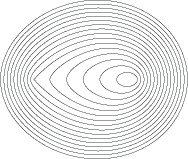
This three-parameter family of curves includes the
above [two-parameter] limaçons of Pascal
as a special case (corresponding to the cartesian ovals which go through a pole).

(2005-06-01)
Bézier Curves
Standard parametric curves used to approximate other curves.
Bézier curves need not be restricted to planar geometry, although they often are.
Pierre Bézier
(1910-1999)
served as an engineer for the French car manufacturer Renault for 42 years,
from 1933 to 1975. He was also a professor at the
Conservatoire national des arts et métiers
(CNAM) from 1968 to 1979.
He introduced the type of curves now named after him
for "free-form curves" within the CAD/CAM system dubbed UNISURF, which he launched in 1968.
The order-n Bézier curve from P0 to Pn
involves n+1 control points (Pi ).
A point M(t) of the curve is the following barycenter of the control points:
| M(t) = |
|
|
æ
è |
n
i |
ö
ø |
t i (1-t) n-i Pi |
Unless otherwise specified, order n = 3 is understood,
in which case alternate names may be used:
"Bézier cubic", "cubic spline" (or just "spline").
Such a curve is given by its extremities A and B and two other control points P and Q:
M(t) =
(1-t) 3 A
+
3 t (1-t) 2 P
+
3 t 2 (1-t) Q
+
t 3 B

As t goes from 0 to 1, M(t) goes from A to B. Assuming distinct control points,
the line AP
is tangent to the spline at point A, whereas BQ is the tangent at point B.
It's good to know that if PQ is parallel to AB and
PQ = AB/3, then the Bézier cubic spline is actually a
parabolic arc.
Thus, it's easy to obtain parabolas from any computer graphic package that provides
Bézier cubics (most of them do).
Bézier curves of order 2 (with a single intermediary control point R)
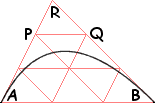 correspond to these same parabolic arcs,
since the relations
correspond to these same parabolic arcs,
since the relations
P = (A+2R)/3 and
Q = (2R+B)/3 imply:
(1-t) 3 A
+
3 t (1-t) 2 P
+
3 t 2 (1-t) Q
+
t 3 B
=
(1-t) 2 A
+
2 t (1-t) R
+
t 2 B
More generally, a Bézier curve of order n (with control points
Pi ) is also a Bézier curve of order n+1 with
control points Qi given by the following relation.
Note that:
Q0 = P0 and
Qn+1 = Pn
[HINT: Expand (1-t) M(t) + t M(t) ]
æ
è |
n +1
i |
ö
ø |
Qi = |
æ
è |
n
i -1 |
ö
ø |
Pi-1 + |
æ
è |
n
i |
ö
ø |
Pi |
Pascal's formula makes this a
barycentric relation:
Qi is between
Pi-1 and Pi
Dr.
Nicholas A. Sceusa (2005-05-29; e-mail)
Piecewise Circular Curves
How may an approximation to an arbitrary curve be constructed
using compass and straightedge?
In the computer era, the most popular approximations for arbitrary curves
involve algebraic splines, like the Bézier curves
discussed above.
For more traditional work, the circle remains, indeed, the basic curve of choice.
The following procedure assumes that the curve we want to approximate
contains no straight sections and no angular points
(otherwise we'd process separately each piece of the curve between these).
To build a smooth curve consisting of circular arcs which approximates the original curve,
we first choose a number of "construction points" located on that
curve. If the curve is open, we must include its extremities among these.
It's also a good idea to include
any inflection points the original curve may have.
(Inflection points are points where the curve crosses its tangent.
Near one of its inflection points, the curve is usually very close to a straight line.)
- Draw the tangent to the curve at each construction point.
- Join two consecutive construction points by a circular arc centered at the
point where the perpendiculars to the relevant tangents intersect.
Such lines always intersect if all inflections points have been included among
the construction points; parallelism would indicate that we're bracketing
an inflection point and need more intermediary construction points.
(A practical alternative is to "cheat" by introducing small straight sections
around inflection points.)
The intrinsic equation of a piecewise circular function
is a step function...
(2005-06-06)
Planar Shape: Intrinsic Equation of a Planar Curve
Defining a shape by its curvature, as a function of curvilinear abcissa.
The curvilinear abscissa (often denoted s) is the arc length
measured along the curve from some arbitrary origin on it
(counted negatively "before" this origin).
At a particular point, the curvature of a planar curve
has a magnitude equal to the reciprocal of its radius of curvature
(the radius of the so-called osculating circle
which best approximates the curve in the immediate neighborhood).
By convention,
the sign of the curvature is positive
if the curves turns to the left
of the direction of an increasing curvilinear abscissa.
The curvature is zero at an inflection point, or at any point of a straight section.
The so-called intrinsic equation (which gives the curvature
of the curve as a function of the curvilinear abscissa along it)
uniquely defines the "absolute" shape of a planar curve
(it could be translated or rotated, but not flipped over).
Infinite curvature: "Planar shapes" are distributions
The above viewpoint is only adequate for smooth curves with no angular points. However,
it's easy to generalize it to angular curves, since the curvature is
the derivative [with respect to curvilinear abscissa] of the angle (in radians)
between some fixed direction and the tangent to the curve.
A sharp turn of q radians at a point
so of infinite
curvature thus translates into a Dirac spike
q d(s-so)
in the intrinsic equation (namely,
a Delta distribution
of amplitude q ).
Dr.
Nicholas A. Sceusa (2005-05-31; postal mail)
On the Quadratrix (or Trisectrix) of Hippias
How could Hippias draw his quadratrix with straightedge and compass?
The quadratrix is the trajectory of the intersection of two straight lines:
One in uniform motion, the other uniformly rotating about a fixed point A.
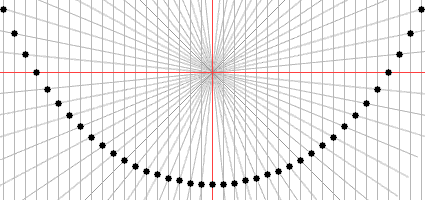
Infinitely many constructible
angles can be used to obtain points of the quadratrix.
In particular, as any angle can be bissected with straightedge and compass,
we may divide a circle in 2, 4, 8, 16, 32, 64...
2 n equal angles.
Draw such radial lines for a sufficiently large n, then
draw any set of equally-spaced parallel lines.
The points where successive radial lines intersect successive
parallel lines are on a quadratrix...
(Intermediary points may be obtained by doubling up the lines in both sets.)
The ancient Greeks only considered those points which could be
deduced from a few given points in finitely many uses of
a straightedge or a compass.
The quadratrix of Hippias was the first curve on record whose points
cannot all be so deduced.
Thus, it's not considered a constructible curve,
although infinitely many points on it can be constructed classically, as shown above.
In the proper coordinate system, the cartesian equation of the quadratrix is:
y = a - x / tan(x/a)
The center of rotation (A) is at (x,y) = (0,a).
The curve's apex (O) is at (0,0).
The main branch is bounded by two vertical asymptotes
(-p < x/a < p)
and corresponds to a full turn of the rotating line.
Only the central portion is usually considered
(-p/2 < x/a < p/2)
which corresponds to a half-turn of the rotating line, between horizontal positions.
The portion where x is positive may suffice.
The curve was devised around 420 BC by
Hippias
of Elis.
It's been called either quadratrix or trisectrix
because it provides graphic solutions to two famous classical problems,
which are now known to be
outside the scope of what can be done with straightedge and compass:
The squaring (quadrature) of the circle and the trisection
of an arbitrary angle.
Also,
Heath
has attributed to
Archytas
of Tarentum
a "quadratrix solution" to the third most famous classical problem of this kind,
the duplication of the cube, or Delian problem.
Legend has it that the Delian problem dates back to 430 BC,
when the Oracle of Apollo at Delos said the plague ravaging Athens would come to
an end if the altar of Appollo could be made exactly "twice as large"
[by volume].
The cube root of 2 is still occasionally known as the Delian constant.
The quadratrix can be used to "square the circle" because the number
p (which can't be constructed with straightedge and compass)
is simply obtained as the ratio of the width to the height of the section of
the quadrarix whose extremities are on an horizontal line through A.
To obtain a portion l of an arbitrary angle
(including l = 1/3) whose vertex is at point A,
consider the two points where its sides intersect the main branch of
the quadratrix.
Draw trough them 2 lines parallel to the axis of the quadratrix.
If M is the point where the quadratrix intersects a third
parallel line dividing the space between them
in the ratio l, then
the line AM divides our angle in the ratio l.
This wonderful curve is thus directly related to yet another famous problem:
the construction of an n-sided regular polygon.
Equilateral triangles, squares, regular pentagons and hexagons are all
constructible with straightedge and compass, but it turns out that
regular heptagons, enneagons,
hendecagons, or tridecagons cannot be so obtained.
This was established in 1796 by Carl Gauss (at age 19) who showed the heptadecagon
(17 sides) to be classically
constructible.
(2005-06-06)
A Parabola is an Example of a Constructible Curve
Locating any point on a parabola, with only straightedge and compass.
A parabola is the set of all points of the plane at an equal distance from
a given point (called the parabola's focus)
and a given line (the parabola's directrix).
The parabola is called "constructible" because its intersection with
an arbitrary straight line, or an arbitrary
circle, can always be
located in finitely many steps using only straightedge and compass.
Thus, allowing the use of of a parabolic spline in addition to straightedge and
compass would not introduce any additional "constructible" points.
This could make classical geometry easier, but not richer.

(2005-06-20)
The Mohr-Mascheroni Theorem:
All constructible points can be obtained with the compass alone.
This statement about classical planar geometry used to be credited to
Lorenzo
Mascheroni (1750-1800) who proved it in
Geometria del compasso (1797).
However, 125 years earlier, the Danish mathematician
Georg
Mohr (1640-1697) had published anonymously a book entitled
Euclides Danicus (1672)
which contains a prior proof...
This was completely overlooked until 1928, when a copy of that little-known work
surfaced in a bookstore
(there's no record of any copy ever sold before then).
Classical constructions which avoid the use of a straightedge are
thus now best called
Mohr-Mascheroni
constructions.
Georg Mohr had also shown that all Euclidean
constructions could be done with only a straightedge,
if a circle of given center is already drawn somewhere in the plane.
The Swiss mathematician
Jakob Steiner (1796-1863) rediscovered this
in 1833 (Steiner constructions).
We may prove that all constructible points can be obtained
with the compass alone by providing Mohr-Mascheroni constructions
for the two types of points which normally involve the use of the straightedge:
- The intersections of a straight line and a circle.
- The intersection of two straight lines.
We'll do so using only two explicit Mohr-Mascheroni constructions,
concerning the inversion with respect to a circle and
the circumcenter of three points.
The very simple construction we'll provide for the former isn't completely
general unless supplemented by a scaling-up procedure, like the following one:
Doubling up, with the compass alone :




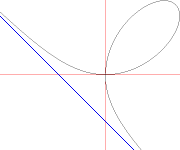


 This famous mathematical group included
the likes of
Pierre Hérigone (1580-1643),
Claude Mydorge (1585-1647),
Girard Desargues (1591-1661),
Pierre Gassendi (1592-1655),
Jean Beaugrand (1595-1640),
René Descartes (1597-1650),
Claude Hardy (1598-1678),
Pierre de Carcavi (1600-1684)
and also Gilles Personne de Roberval (1602-1675)
who is the one who actually named the limaçon after Etienne Pascal
in 1650, when he used it as an example for the drawing of tangents.
This famous mathematical group included
the likes of
Pierre Hérigone (1580-1643),
Claude Mydorge (1585-1647),
Girard Desargues (1591-1661),
Pierre Gassendi (1592-1655),
Jean Beaugrand (1595-1640),
René Descartes (1597-1650),
Claude Hardy (1598-1678),
Pierre de Carcavi (1600-1684)
and also Gilles Personne de Roberval (1602-1675)
who is the one who actually named the limaçon after Etienne Pascal
in 1650, when he used it as an example for the drawing of tangents.


 correspond to these same parabolic arcs,
since the relations
correspond to these same parabolic arcs,
since the relations
